Hello and welcome to VOV’s Letter Box, our weekly feature dedicated to our listeners throughout the world. We are Mai Phuong and Phuong Khanh.
A: Spring has come. The weather has become warmer with more sunshine and it’s time to go to spring festivals.
B: You remind me of a Vietnamese saying that January is the month for playing, February is the month for gambling, and March is the month for festivals.
A: That means we don’t have to work during the first three months of the year. That’s excellent.
B: You’re right. But saying so, Vietnamese people want to talk about the richness of the Vietnamese culture and the diversity of Vietnamese festivals. Vietnam has more than 8,900 festivals including more than 7,000 folk festivals. They are intangible cultural heritages which have been preserved and promoted nationwide.
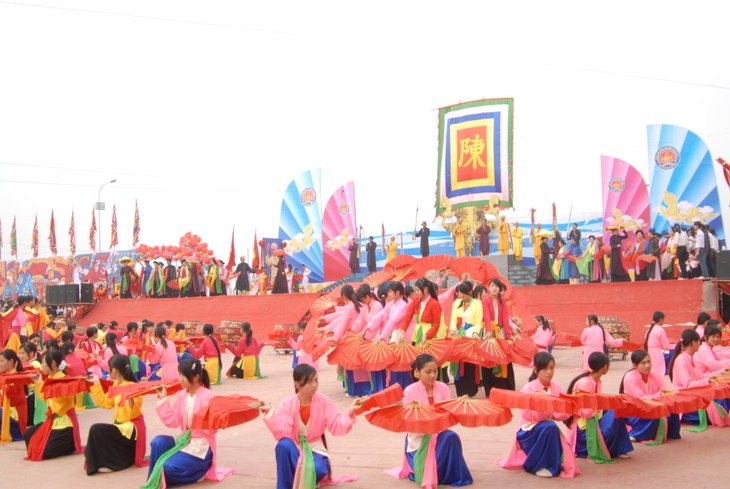
Tran temple festival opens in Thai Binh province |
A: Vietnamese festivals are variously categorized as agricultural festivals, religious festivals, competitions of folk singing and games, and cultural festivals honoring local heroes and traditions.
B: The biggest number of festivals are held in the spring, after Tet, so it’s advantageous to visit Vietnam at this time of the year so you can attend the festivals and learn more about Vietnamese culture.
A: Pak Ning Tjang of Indonesia says the weather there is not too good. The sky is always dark and it’s dizzling. Pak Ning Tjang monitored our program on February 29 at 12020 khz from 1000 to 1027 UTC and rated SINPO at 44334. He wants to know more about ancient houses in Cai Be district in southern Vietnam.
A: The ancient village of Dong Hoa Hiep in Cai Be District, Tien Giang Province, is famous for its beauty, formed by the calm Cai Be River and ancient houses amid orchards that are lush and laden with fruit all year round.
B: Along with two other ancient villages - Duong Lam in Hanoi and Phuoc Tich in Hue - Dong Hoa Hiep was selected to be developed into a rural tourism model by the Vietnam National Administration of Tourism and the Japan International Cooperation Agency (JICA).

A corner of Dong Hoa Hiep village |
A: Houses in Dong Hoa Hiep are different from the houses built in close proximity to each other in Duong Lam and Phuoc Tich. Dong Hoa Hiep’s houses are scattered in lush orchards and embraced by the winding Cai Be River.
B: Visitors to the village enjoy pure air and peaceful scenery while rowing boats on the river or strolling through the shady orchards.
A: One destination that has made a vivid impression on visitors is the ancient house owned by Tran Tuan Kiet. It was built around 1838 with 108 pillars made of xylia xylocarpa, a valuable and rare wood, in a 1.8ha orchard. The house was designed in the architectural style of southern garden houses with five large rooms covering 1,000m2.
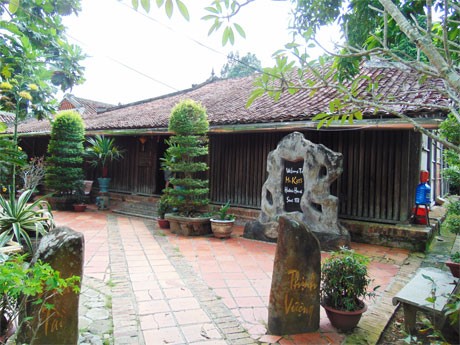
Mr. Tran Tuan Kiet's ancient house in Dong Hoa Hiep
|
B: The house has been preserved intact with its refined patterns of "pine trees, daisies, ivory bamboo and apricot trees"carved on wooden pillars and doors. Inside, the house displays sets of parallels inlaid with mother-of-pearl, skillfully carved furniture and ancient ceramics.
A: Le Thi Chinh, the owner’s wife, said her husband's great-grandfather was the chief of the district who was so keen on antiquities that he invited craftsmen from the imperial capital of Hue to build the house over a several years and spent a lot of time and efforts collecting many valuable ancient objects.
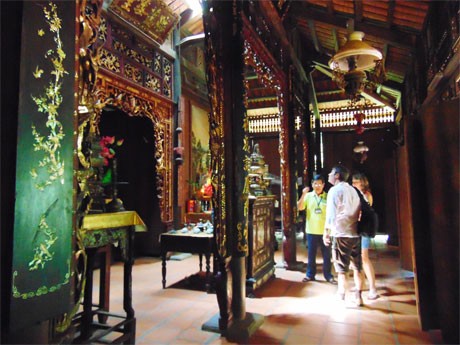
Inside Mr. Tran Tuan Kiet's house |
B: In 2002, the Japan International Cooperation Agency (JICA) put up 1.8 billion VND to restore the house under the supervision of a female Japanese architect who lived in the house for over six months. Thanks to JICA's support, the house was restored to its original architectural and interior style.
A: A second popular destination in Dong Hoa Hiep is Nguyen Van Duc's house which was built in 1850 with a blend of Oriental and Western architecture. The front of the house was constructed in the French style with round Western pillars and romantic domes whereas the inside was designed in a traditional Vietnamese style.
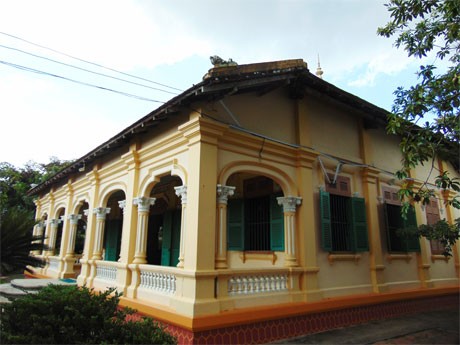
Mr. Ba Duc's ancient house in Dong Hoa Hiep |
B: The house still contains many rare ancient objects that demonstrate the comfortable lifestyle and refined hobbies of rich families in southern Vietnam’s past. Each year, Dong Hoa Hiep attracts almost 100,000 visitors with an increasing number of foreign tourists.
B: Here’s an email from Richard Nowak of the US. He listened to our broadcast on 6175 khz from 0101 to 0127 UTC using a 1956 Hallicrafters Sx 99 hooked up to an off center fed dipole with an overall length of 41 meters and said he particularly liked the segment on Ritual singing.
A: Richard wrote: “Your great Sunday Show had a very interesting and enjoyable segment on Vietnamese Ritual singing. Traditionally 2 instruments were used and the bamboo flute and zither are incorporated. Interesting interviews were given and worship singing in the temple was discussed. Shows like this give listeners an understanding of traditions and culture in Vietnam. The segment was great”.
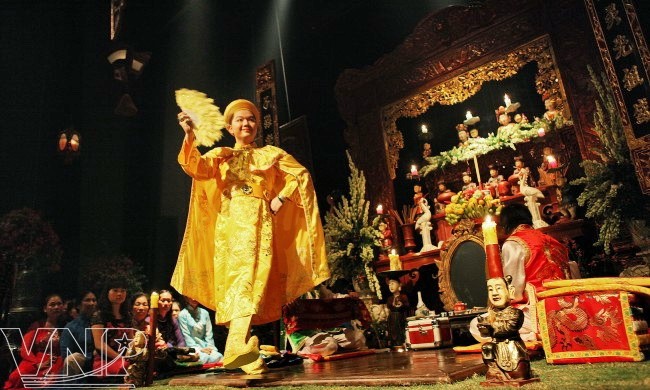
Chau Van ritual singing |
B: Thank you, Richard, for your comments. On today’s show, we’d like to thank Jorge Roberto Verdecia Ramirez of Cuba for sending us congratulations on Radio Day and for tuning in to our broadcasts. We had to ask the Spanish section to translate your emails. Next time could you please send us your feedback in English? We hope to hear more from you.
A: Charlie Wardale of the UK also listened to VOV’s Sunday show on February 28 and reported that the signal on 5955 khz relayed from the Moonsbrum transmitter in Austria was excellent.
B: He wrote: “I was very interested to hear about the Vietnamese ritual singing and the description of the various instruments used, and how much people enjoy singing this type of music”.
A: Thank you, Charlie, for your report. John Rutledge, an American listener in China, sent us a letter this week. He wrote: “Thank you for your broadcasts. I continue to enjoy them whenever I can hear them. The broadcasts always remind me of the good memories from my visit to your country and your radio station last September. My story and photos from last year’s visit also has caused a couple of my friends to start listening to your station. Programming content remains good and I hope that you don’t change it drastically in the near future”.
B: John Fisher of the US listened to VOV on January 21st on the frequency of 6175 and rated SINPO at all 4s. He wrote: “I enjoyed the broadcast very much. It was interesting to learn of the events concerning the 12th National Party Congress. I also enjoyed the Letter Box and hearing about the Flower villages. I hope you will continue to broadcast on shortwave. Your station is a great source of news about Vietnam. I also enjoy the music which I find quite beautiful”.
B: We have received two other letters from Samuel Carlos De Santana of Brazil. Samuel sent us reports on our programs on November 15th and December 31st on the frequency of 6175 kz using Sony ICF SW 77 with a telescopic antenna. Rating the programs with SINPO of 33222 and 34333 respectively, Samuel wrote: “I’m very happy to listen to the Voice of Vietnam today, the last day of the year in Brazil but the first day of 2016 in Vietnam. Congratulations for the best broadcasting”.
A: Thank you, Samuel, for your reports. We’ll send you QSL cards to confirm them as well as a frequency list and a program schedule. Today, we’d also like to acknowledge letters and emails from Mr. Juha Tuominen of Finland, Kachan Chatterjee, Ratan Kumar Paul, Anan Homan Bain, and Debakamal Hazarika of India, Mark Goddard of the UK, who sent us a beautiful postcard of a clock tower, Toshiya Nishimura and Fumito Hokamura of Japan, and Christer Carnegren of Sweden. We have sent you QSL cards to confirm your reports.
B: We welcome your feedback at: English section, Overseas Service, Radio Voice of Vietnam, 45 Ba Trieu Street, Hanoi, Vietnam. Or you can email us at: englishsection@vov.org.vn. You’re invited to visit us online at www.vovworld.vn, where you can hear both live and recorded programs. Before wrapping up our show, let’s listen to a song called….. We’d like to dedicate this song to Giovanni Ricci of Italy who asked whether we broadcast Vietnamese music. Good bye until next time.